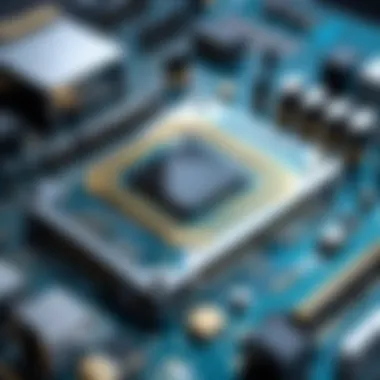Exploring the Future of AI: Intel's Habana Acquisition


Intro
The acquisition of Habana Labs by Intel marks a pivotal moment in the evolution of artificial intelligence and computing technologies. This transaction aligns strategically with Intel’s ongoing efforts to enhance its position in the AI landscape. As the demand for AI-driven applications continues to escalate, understanding the implications of such acquisitions is critical for stakeholders across the tech industry.
Habana Labs specializes in AI acceleration, particularly through its Gaudi processors, which are designed to optimize deep learning workloads. Integrating these innovations into Intel’s extensive portfolio may not only enhance hardware performance but could also redefine market dynamics across multiple sectors. The significance of this merger goes beyond mere product enhancement; it signals a shifting paradigm in hardware design and market strategy.
This article will navigate through the intricate elements of this acquisition. We will explore how Integrated AI solutions can transform operational performance, discuss potential implications for competition in the AI space, and analyze the broader impact on future product development across the industry. Through this examination, we aim to provide a clear perspective on the future directions prompted by this acquisition.
Preamble to Habana Labs
Habana Labs plays a crucial role in the context of artificial intelligence and computing advancements. Its foundational technologies and innovations are vital for understanding the implications of its acquisition by Intel. The acquisition reflects broader trends in the tech industry, where strategic partnerships and integrations are essential to staying competitive.
A clear understanding of Habana Labs helps illuminate how Intel aims to strengthen its position in the AI space. This section will cover the foundational aspects of Habana Labs and its significance in technology.
Foundational Overview
Habana Labs was founded in 2016, emerging from a vision to create high-performance computing solutions for AI workloads. The company focuses on designing purpose-built processors for machine learning and deep learning applications. Its architecture demonstrates a significant shift from traditional CPU-centric computing.
The company has developed two main processors: Gaudi and Goya. Gaudi is designed for training AI models, providing a substantial performance boost, whereas Goya is tailored for inference tasks. The ability to handle complex neural networks efficiently positions Habana Labs as a key player in a rapidly evolving landscape.
Key Innovations and Products
Habana Labs' innovations center around optimized hardware that pushes the boundaries of what's possible in AI computing. The Gaudi processor employs advanced features, including multi-threading capabilities and high bandwidth memory. These elements improve the efficiency of deep learning training processes, making it suitable for data-driven industries.
Goya, on the other hand, focuses on high-performance inferences with minimal latency. Its architecture allows for faster processing of AI inference requests, catering to applications such as autonomous driving and real-time data analysis.
"By transforming the landscape of AI hardware, Habana Labs has set new standards in performance, which Intel now aims to leverage across its product suite."
The unique features of Habana's products not only address current needs in AI development but also set the stage for future advancements as AI technologies mature. The integration of these products into Intel's portfolio promises to accelerate innovation and strengthen Intel's market position.
The Acquisition Timeline
The acquisition timeline provides critical context for understanding the significance of Intel's purchase of Habana Labs. This timeline encapsulates key milestones, crucial decisions, and negotiating stages that ultimately led to the deal's finalization. Recognizing these moments helps clarify not only the strategic motivations behind the acquisition but also the dynamic shifts in the artificial intelligence landscape.
Announcement and Background
In December 2019, Intel officially announced the acquisition of Habana Labs, a leader in AI hardware. This announcement marked a watershed moment, reflecting the increasing importance of artificial intelligence in the tech industry. Intel recognized that acquiring Habana would bolster its competitive edge in AI computing.
Habana Labs was founded with a clear vision: to develop specialized AI processors that outperform traditional CPUs. Their two flagship products, the Gaudi and Goya chips, targeted high-performance computing applications, especially in training and inference workloads.
The background leading to this acquisition was marked by escalating demand for AI processing capabilities. Major players in the tech sector were keen on advancements that could handle vast amounts of data efficiently. Through this acquisition, Intel aimed to position itself favorably amidst a rapidly evolving market. The move was not just to gain technology; it was also about acquiring talent and intellectual property that could accelerate Intel’s AI roadmap.
Details of the Acquisition Deal
The acquisition deal was concluded at a reported valuation of approximately $2 billion. This figure highlights the significance of Habana Labs within the AI sphere. Intel's decision indicates a broader trend of consolidation in the semiconductor industry, especially regarding AI technologies.
In terms of specifics, the deal was structured to allow Habana to operate with a degree of independence within Intel's existing framework. This approach was pivotal for ensuring that Habana's innovative culture persisted, ultimately aiding in further advancements in AI solutions.
Moreover, Intel committed to integrating Habana's technology into its product offerings effectively. This integration aims to optimize Intel's existing architectures while enhancing the functionality of both companies’ products. The acquisition underscores Intel's goal to be at the forefront of AI, as it combines Habana's cutting-edge technology with its extensive market reach.
"The acquisition of Habana Labs will significantly enrich Intel's portfolio, equipping us to accelerate our capabilities in AI and machine learning." - Intel Executive
Through this timeline, readers gain insights into the mechanics of the acquisition and the strategic foresight of Intel in harnessing AI potential. Understanding these aspects creates a framework for anticipating Intel's future movements in the AI domain.
Strategic Importance of the Acquisition


The acquisition of Habana Labs by Intel marks a significant turning point in the dynamics of the artificial intelligence (AI) and computing landscapes. This step not only symbolizes Intel's commitment to enhancing its portfolio but also sets the stage for strategic positioning against competitors in the fast-evolving tech market. The integration of Habana's specialized AI processors is crucial for addressing demand in various sectors that are increasingly reliant on AI-driven solutions. By understanding the strategic implications of this acquisition, we can better grasp how Intel plans to secure its place at the forefront of AI innovation.
Positioning Against Competitors
The competition in AI hardware has become fiercely intense, with companies like NVIDIA and AMD constantly developing new technologies to capture market share. Intel's acquisition of Habana serves as a calculated move to bolster its competitive edge.
- Leverage AI Capabilities: Habana's expertise in developing AI-centric chips allows Intel to enhance its offerings for data centers, a segment where precision and performance are critical.
- Market Differentiation: With Habana's technology, Intel can introduce products that are not just incremental upgrades but rather disruptive innovations that can redefine industry standards.
This strategic alignment is pivotal in countering the advancements made by rival firms. While other companies focus on graphics processing units, Intel's new products can potentially streamline computations needed for complex algorithms employed in machine learning and deep learning applications. This positioning is not just reactive; it is a proactive step to create a unique value proposition in a growing market.
Enhancing Intel's Product Portfolio
The integration of Habana Labs into Intel's ecosystem presents numerous opportunities for enhancing product offerings.
- Diversity of Solutions: The addition of AI processing capabilities complements Intel's established platforms and allows the creation of specialized products targeting specific market segments such as autonomous driving, healthcare, and smart cities.
- Unified Development Approach: By harnessing Habana's innovations, Intel can focus on a robust pipeline of AI and computing technologies that cater to diverse business needs and can adapt to fast changes in technology.
The synergy created through this acquisition enables Intel to offer more comprehensive solutions. This enhancement reflects Intel's vision for a future with AI deeply integrated into computing processes, propelling user experiences to new heights.
The acquisition represents not just a portfolio addition, but a shift in how Intel aims to influence AI applications in multiple industries.
Market Reactions and Analyst Predictions
The acquisition of Habana Labs by Intel has created significant interest within financial markets and among technology analysts. Understanding the market reactions and predictions from analysts is crucial. These insights can reveal public sentiment and anticipated future developments in the AI sector. Moreover, they allow investors to gauge the potential performance of Intel's stock and product offerings post-acquisition.
Investor Sentiment
Following the announcement, the investor response has shown mixed feelings. Some investors express optimism regarding Intel's commitment to advancing its AI efforts. The potential for enhanced processing capabilities and AI-driven applications is seen as a positive indicator for future growth.
Conversely, caution prevails among certain investors. Concerns over operational integration and the actual impact of Habana's technology on Intel's existing line-up may affect stock performance. Some fear that integrating new technologies can take time and be resource-intensive, which could delay the anticipated benefits. Factors influencing investor sentiment include:
- Market Position: Intel's historical dominance in the CPU market could see challenges as it shifts to include specialized AI solutions.
- Profitability Concerns: Short-term financial impacts of the acquisition may deter some investors who prefer quicker returns.
In summary, investor sentiment reflects a blend of anticipation and skepticism, demonstrating the need for Intel to effectively communicate its strategic vision.
Analyst Forecasts Post-Acquisition
Analyst forecasts present a nuanced view of what the acquisition means for Intel and the AI landscape. Many analysts predict that Habana's technology will strengthen Intel’s competitive position against rivals like NVIDIA and AMD. Enhanced offerings in AI workloads are seen as a potential game-changer.
Some key predictions include:
- Revenue Growth: Analysts expect a gradual increase in revenue streams tied to AI. They particularly highlight data centers as key beneficiaries of Habana's innovations.
- Market Share Expansion: The successful integration of Habana's capabilities may allow Intel to capture a larger share of the AI chip market, traditionally dominated by other players.
Analysts emphasize the importance of Intel's execution on its AI strategy. They suggest that maintaining strong leadership in product development will be essential.
"The real test of this acquisition lies not only in integration but also in how Intel communicates its future plans to stakeholders. Transparency will be crucial for maintaining investor confidence."
Technological Implications of Habana's Integration
The integration of Habana Labs into Intel's operations carries significant technological implications. This acquisition reflects a strategic intent to enhance Intel's position in artificial intelligence computing. Habana's innovative products and technologies are positioned to redefine the landscape of AI workloads and computing architectures.
Impact on AI Workloads
Habana Labs provides distinctive processors designed specifically for AI workloads. These processors can accelerate the performance of complex models used in machine learning and deep learning applications. The Gaudi architecture, for instance, is focused on training, while the Goya architecture is suited for inference tasks.
Key Benefits of Incorporating Habana Technologies:


- Performance Efficiency: Habana processors optimize runtime, reducing the time required for training AI models.
- Cost-Effectiveness: By delivering high performance per watt, they enable enterprises to manage energy costs effectively.
- Scalability: AI applications, especially in natural language processing and computer vision, require substantial computational power. Habana's technologies can seamlessly scale to match these demands.
"Intel's acquisition of Habana Labs may signal the shift towards more specialized hardware solutions in AI workloads, reshaping how companies approach machine learning and deep learning."
As workloads become increasingly demanding, the ability to process larger datasets with greater speed will be critical. This advantage can enhance applications across various sectors, from autonomous systems to advanced data analytics.
Advancements in Computing Architectures
The advancement in computing architectures facilitated by Habana's technology is crucial for Intel's future. Traditional CPU architectures are not always suited for high-performance AI tasks. Habana's contributions bring about a paradigm shift towards hybrid architectures integrating CPUs, GPUs, and specialized processors.
Considerations for Future Architecture:
- Accelerated Processing: Specialization in processing allows for enhanced performance when running parallel tasks, critical for AI applications.
- Reduced Latency: With dedicated hardware, data flows more efficiently, decreasing latency in real-time computational tasks.
- Modular Designs: Incorporating Habana innovations can lead to more modular systems, allowing businesses to customize their resources based on specific needs.
The horizon for computing architectures is expanding. By bolstering its portfolio with Habana Labs, Intel has the potential to become a leader in pioneering hybrid models that can accommodate a diverse range of workloads. As this integration unfolds, the focus will likely be on balancing cost, performance, and scalability to meet future AI demands.
Future Directions for Intel's AI Strategy
The acquisition of Habana Labs by Intel opens new pathways for the company's AI strategy. With growing global demand for advanced artificial intelligence capabilities, Intel aims to shift its focus towards a more specialized approach in AI computing. This strategic pivot can potentially enhance Intel's standing in an increasingly competitive market. An in-depth look at Intel's long-term ambitions and the emerging market opportunities helps illustrate the broader implications of this acquisition.
Long-Term Goals
Intel's long-term goals, shaped significantly by the integration of Habana's technology, focus on refining performance in computing tasks that heavily rely on AI, such as machine learning and deep learning. By investing in these areas, Intel intends to diversify its offerings beyond traditional CPU markets, reinforcing its competitive edge. The ambition to develop specialized hardware geared toward AI workloads allows Intel to address specific needs of customers more effectively, enhancing user experience and performance.
Additionally, there is a recognition that staying ahead of rivals requires proactive innovations. Intel is expected to increase its research and development efforts, ensuring that future products incorporate cutting-edge AI algorithms and architectures. These efforts will not only involve planning for short-term product releases but also laying the groundwork for long-term advancements in AI technologies.
Emerging Market Opportunities
New market opportunities are arising as organizations realize the potential of AI solutions across industries. Intel's acquisition of Habana Labs positions the company to capitalize on these trends swiftly. Key areas of interest include:
- Edge Computing: With an increasing shift to edge computing, data processing is moving closer to the source of data generation. Intel can leverage Habana's technology to create powerful processors that cater to this need.
- Cloud Services: The demand for cloud computing continues to soar. By integrating Habana's advanced AI capabilities, Intel can better serve cloud service providers looking for efficient solutions to manage AI workloads.
- Autonomous Systems: AI is crucial for the development of autonomous vehicles and drones. Intel’s strength in hardware can be complemented by AI innovations from Habana, giving rise to competitive offerings in this area.
"The future is here; it’s just not evenly distributed yet." - William Gibson
By focusing on these strategies, Intel can effectively navigate the complexities of the AI industry.
Challenges Ahead
The acquisition of Habana Labs by Intel marks a significant shift in the landscape of AI and computing. However, challenges are inherent in any significant merger. Understanding these obstacles is essential to grasp how they may affect future developments in both the companies involved and the broader industry.
Operational Integration Issues
Integrating Habana Labs into Intel's existing operations poses a number of complexities. This merger is not only about combining products but also about aligning company cultures, operational processes, and strategic goals. One primary consideration is the need to retain Habana’s talent while integrating them into Intel's larger framework. The loss of key personnel can hinder innovation amid a transitional phase.
Dilution of Habana's distinct identity is another potential risk. Many successful tech companies have their own unique approaches, and merging these can lead to conflicts. This could stall ongoing projects that utilize Habana's proprietary technologies, such as their Goya processors and Gaudi AI training chips.
Furthermore, synchronization of product management and marketing strategies will be critical. If both divisions do not work seamlessly together, confusion may arise in the marketplace, leading to a diluted brand presence.
Anticipating Competition Moves
As Intel navigates this acquisition, it must remain vigilant of competitive strategies employed by other key players in the AI and computing arena. Companies like NVIDIA and AMD have shown resilience in adapting to market changes. Intel's response to these moves can impact their market share and relevance.
NVIDIA’s prowess in AI graphics processing has made it a formidable opponent. Their recent foray into AI-centric hardware has set higher expectations across the industry. Similarly, AMD's strengthened position in cloud gaming and machine learning allows it to capture significant market segments. Intel's strategies must account for these competitors' innovations and shifts in their product offerings.
In summary, Intel's acquisition of Habana Labs offers considerable prospective benefits. However, operational integration challenges and competitive moves from rivals create a landscape that Intel must tread carefully. Keeping a close eye on industry trends and maintaining effective integration practices will be vital for Intel's success.


Broader Trends in AI Hardware Development
The landscape of AI hardware development has evolved rapidly. The acquisition of Habana Labs by Intel is part of a larger context that influences these changes. Trends in AI hardware development indicate a shift toward specialized processors and collaborative efforts in chip design, which are key themes for understanding the implications of this acquisition. Specialized processors play a critical role in improving AI capabilities. They allow for efficient execution of complex algorithms that traditional CPUs cannot handle as effectively. This trend highlights the growing recognition within the industry that generalized hardware may no longer suffice for AI workloads.
Shift Towards Specialized Processors
The increasing demand for more efficient AI computation has led to significant interest in specialized processors. These include Graphics Processing Units (GPUs) and Tensor Processing Units (TPUs). Such hardware is designed specifically for machine learning tasks. Traditional processors faced limitations in handling large datasets and computationally intensive models.
For example, Intel's move to acquire Habana Labs, known for its Gaudi processors, signifies a clear intention to expand its offerings in specialized hardware. This move emphasizes performance optimization for AI workloads. The expectation is that these specialized processors will provide a competitive edge in speed and efficiency over standard processors.
- Enhanced Efficiency: Specialized processors can execute parallel tasks effortlessly, making them ideal for deep learning models.
- Cost Effectiveness: By optimizing energy consumption, companies can reduce operational expenses.
- Future Scalability: These processors can handle growing workloads as AI technology becomes more advanced.
The acquisition allows Intel to address the increasing necessity for tailored AI solutions. Therefore, the trend toward specialized processors not only shapes the future technology but also dictates market survival for companies relying heavily on AI.
Collaboration and Partnerships in AI Chip Design
The complexity of AI hardware development cannot be understated. This complexity has driven companies to form partnerships in chip design. These collaborations aim to leverage unique expertise and resources to create more efficient and powerful AI chips.
Collaboration can take various forms. Companies often work with universities, research institutions, or even each other to share knowledge and innovation. For instance, Intel's strategy may involve partnering with research teams focusing on AI algorithms to optimize the hardware's performance. This fosters an ecosystem of innovation, resulting in superior products tailored for specific applications.
- Shared Expertise: Companies can gain insights into cutting-edge technologies by collaborating with specialists in the field.
- Resource Optimization: Pooling resources can help in speeding up the development process.
- Market Adaptation: Working together allows faster response to market changes and technological advances.
Ultimately, collaboration in AI chip design acts as a catalyst for innovation. With the pressure to advance technologies rapidly, leveraging partnerships could prove vital for success. This synergy not only benefits the companies involved but also advances the entire industry, paving the way for new developments in AI hardware.
Case Studies of Similar Acquisitions
The analysis of previous acquisitions in the technology sector serves as a vital lens through which we can examine the implications of Intel's acquisition of Habana Labs. Understanding how major corporations like NVIDIA and AMD navigate similar transitions can provide insights into best practices, potential hurdles, and the evolving landscape in AI and computing.
NVIDIA's Acquisition of Mellanox
NVIDIA's acquisition of Mellanox Technologies in 2020 is a noteworthy example. Mellanox, known for its high-performance networking technologies, was integrated into NVIDIA’s portfolio to bolster its data center strategy. The deal, valued at approximately $6.9 billion, aimed to enhance NVIDIA's capabilities in AI and data-intensive applications.
Implications and Benefits:
- Strengthened Product Offering: The merger enabled NVIDIA to offer comprehensive AI solutions, combining their graphics processing units with Mellanox's advanced networking technology.
- Market Positioning: Following the acquisition, NVIDIA positioned itself as a leader in the AI hardware market, creating synergy between computing and networking.
- Operational Efficiencies: NVIDIA realized cost savings and enhanced operating margins through the consolidation of R&D efforts.
Overall, NVIDIA's strategic move illustrates how acquisitions can forge stronger product ecosystems, ultimately benefiting both the company and its customers.
AMD's Integration of Xilinx
AMD's acquisition of Xilinx in 2020 represents another significant case study. With a purchase price of $35 billion, AMD aimed to expand its product offerings and enter new markets. Xilinx is known for its field-programmable gate arrays (FPGAs), which are crucial for data centers and AI applications.
Key Considerations:
- Diversification of Products: The acquisition allows AMD to diversify its portfolio, complementing its CPU and GPU offerings with Xilinx’s reconfigurable hardware.
- Enhanced Market Reach: By integrating Xilinx technologies, AMD can reach customers in sectors like telecommunications and automotive, where flexible computing solutions are essential.
- Competitive Edge: This move is seen as a bid to compete more effectively against Intel by providing customers with greater flexibility and performance in their computing needs.
Both NVIDIA and AMD demonstrate that with careful integration and a focus on innovation, acquisitions can significantly redefine a company's strategic direction and market presence.
Finale
The conclusion of this article is significant as it ties together the various elements discussed regarding Intel's acquisition of Habana Labs. The examination of this acquisition reveals crucial insights into the future direction of AI hardware and the shifting landscape of computing technologies. Understanding the implications helps readers grasp not only the immediate effects on Intel's offerings but also the broader impact on the industry as a whole.
Recap of Key Points
Throughout the article, several key points emerged that illustrate the importance of this acquisition:
- Strategic Positioning: Intel's acquisition of Habana Labs positions the company more effectively against competitors in the AI hardware market. This strategic move enhances Intel's capabilities in machine learning and deep learning.
- Innovative Product Portfolio: Integrating Habana's technologies into Intel's existing product lines broadens its potential offerings and appeals to a wider range of customers in the AI field.
- Market Predictions: Analysts forecast positive trends for Intel post-acquisition, highlighting expected growth in AI-driven applications and technologies.
- Challenges and Competition: While there are opportunities, challenges in operational integration and increased competition must be considered. These factors will shape future decisions and strategies.
Final Thoughts on the Future of AI and Computing
The landscape of AI and computing is evolving rapidly. As companies like Intel continue to invest in acquisitions, the focus will shift toward specialized solutions for more efficient processing of AI workloads. The integration of Habana’s capabilities is expected to accelerate AI advancements by reducing the time and cost associated with AI development.







